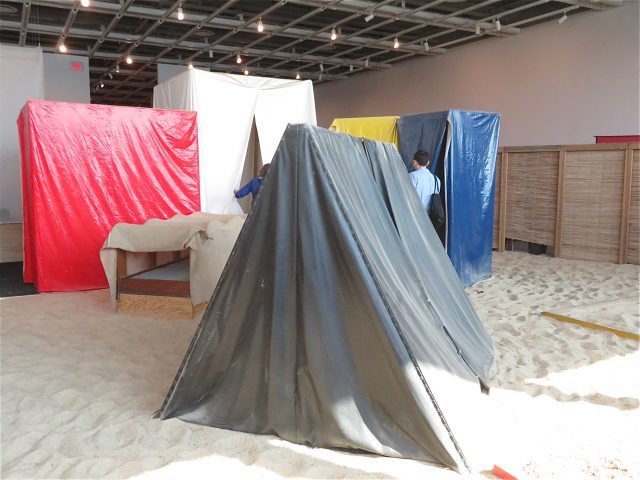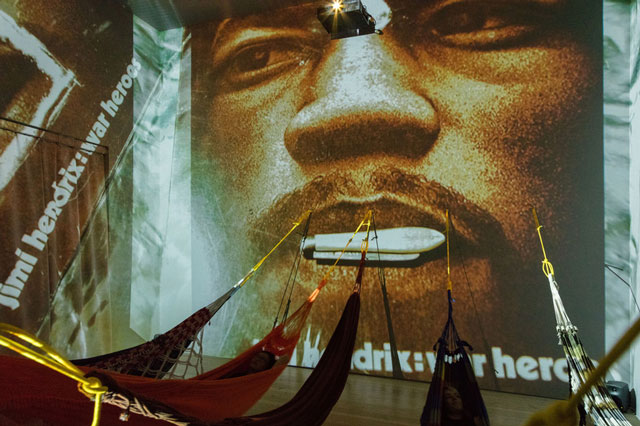
Whitney retrospective offers a journey into Hélio Oiticica’s colorful “Éden” (photo by twi-ny/mdr)
Whitney Museum of American Art
99 Gansevoort St.
Through October 1, $18-$25
212-570-3600
whitney.org
In 1971, Brazilian artist and activist Hélio Oiticica proposed “Subterranean Tropicália Projects,” a participatory public artwork for Central Park. While it never was realized, the extensive Whitney retrospective “Hélio Oiticica: To Organize Delirium” is a kind of indoor interactive park, offering visitors entry into a communal, collaborative space in New York City. The exhibition, which continues through October 1, comprises painting, sculpture, film, writings, installation, and paraphernalia documenting Oiticica’s too-brief career, which included a seven-year period in the Lower East Side in Manhattan that initially fueled his artistic desires but ultimately left him frustrated and disappointed. “I feel as if I’m in prison in this infernal island,” he wrote to Lygia Clark regarding immigration problems related to his homosexuality. A Neo-Concretist who was also a member of Grupo Frente, he died in Brazil in 1980 from a massive stroke at the age of forty-two. However, “To Organize Delirium” is filled with life, and the more you put into the show, the more you can understand Oiticica’s methods — while having a great time. You can take your shoes off and walk barefoot through water, sand, and gravel in “PN27 Penetrable, Rijanviera” and greet parrots, watch an infomercial, and read poems by Roberta Camila Salgado in “Tropicália,” Oiticica’s groundbreaking 1967 installation that gave its name to the Brazilian musical, artistic, and sociopolitical movement that emerged from South America in the 1960s. You can wave a flag, take a rest on an enclosed mattress, and walk through sand, dry leaves, water, foam flakes, crushed bricks, and straw in “Éden,” while in another room you can put on any of numerous politically tinged Parangolé capes and dance with dissidents in a digital slideshow.

Hélio Oiticica, installation view, “CC5 Hendrix-War,” thirty-three 35mm color slides transferred to digital slideshow, sound, and hammocks, 1973 (Site Specific Collections of César and Claudio Oiticica and Neville D’Almeida. Whitney Museum of American Art, New York, N.Y. Photograph by Oto Gillen)
You can play a game of pool as part of “Appropriation — Snooker Room, after Van Gogh’s ‘Night Café.’” For “Block Experiments in Cosmococa, Program in Progress: CC1 Trashiscapes,” you are encouraged to sit on a mattress or pillow in a large room and file your nails while watching slides and listening to music, combining creativity and leisure, what Oiticica called “creleisure,” which references the artist’s use of cocaine. You can gently swing in a hammock and groove to Jimi as part of “CC5 Hendrix — War,” a collaboration with Neville D’Almeida. Unfortunately, you no longer can interact with such architectural works as “NC1 Small Nucleus 1” and “PN1 Penetrable” because they are too fragile, but you can marvel at how they evoke the geometric patterns Oiticica used in his painting series “Metaesquema” and his plywood “Spatial Reliefs.” There are also unedited films of the Gay Pride Parade, the Fillmore East, the South Bronx, drag performer Mario Montez, and artist Lee Jaffe playing on small monitors. It’s a revelatory show about an important, utterly original twentieth-century artist who immersed his oeuvre in social and political concerns while inviting everyone into a playful world where art is everywhere. To get in the mood for the exhibition, the Whitney has a Tropicália playlist, with music by João Gilberto, Antônio Carlos Jobim, Os Mutantes, the Velvet Underground, Jimi Hendrix, the Beatles, Caetano Veloso and Gilberto Gil, and others that you can listen to here.